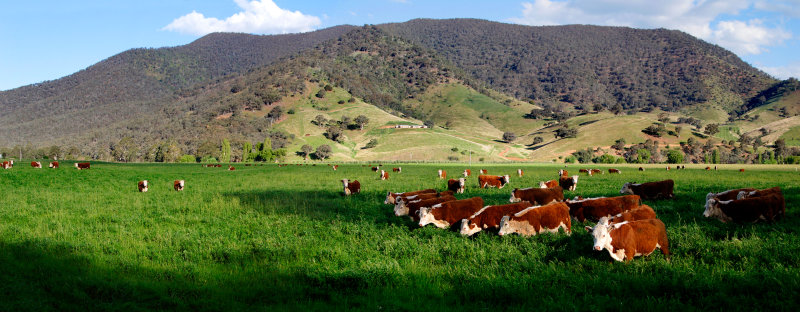|

Figure 60. Hereford cattle grazing.3.249 Photo credit3.250.
Grandpa fed the cattle at his farm on the Santa Clara Creek west of St. George, Utah in the winter. When the snow melted in the spring, the cattle were trucked 50 miles to the north to Calf Springs Ranch, which
is 7 miles south of Enterprise, Utah, to graze in spring fed mountain meadows for the summer. From the time I could walk until a few years after Grandpa died I would spend time each summer at Calf Springs Ranch. When I was about 7, a horse was scared by a rattlesnake and ran away with me, stopping for a fence, throwing me over it's head, where I landed on a volcanic rock, was unconscious for several hours, and woke up 50 miles away in Cedar City at the hospital. There were a lot of stories young boys remember. Like the time one of the cows was tired
of being mounted, kicked back with both feet, catching a young bull right where
it hurts, who spent several hours crying out in pain. Or Grandpa's jerky stick, which when someone was just swallowing a chew he would tell them it was made from a Rocky Mountain Oyster. As graphic these learning experiences were, it was
obvious there is a definite order to how cattle, and by extension all life, reproduces. Cows make baby cows, sheep make baby sheep, pigs make baby pigs, owls make baby owls, water snakes make baby water snakes, etc.
Dad always had a herd of about 35-50 Hereford cows and their calves, which was part of Mom's inheritance from Grandpa Hafen. We had a cattle drive each spring, to move the cattle about 35 miles to the northwest, out to the desert property, to graze and raise their calves during the summer.
In the fall we would bring them back to the feed yard, and fatten the steers until they were big enough to process for meat through Nelson Meat Packing Plant.
I was an officer in the Utah Junior Hereford Association one year, and was able to go to the National Convention in Wichita, Kansas.
|